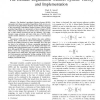Free Online Productivity Tools
i2Speak
i2Symbol
i2OCR
iTex2Img
iWeb2Print
iWeb2Shot
i2Type
iPdf2Split
iPdf2Merge
i2Bopomofo
i2Arabic
i2Style
i2Image
i2PDF
iLatex2Rtf
Sci2ools
ARITH
2005
IEEE
2005
IEEE
The Residue Logarithmic Number System: Theory and Implementation
— The Residue Logarithmic Number System (RLNS) represents real values as quantized logarithms which, in turn, are represented using the Residue Number System (RNS). Compared to the conventional Logarithmic Number System (LNS) in which quantized logarithms are represented as binary integers, RLNS offers faster multiplication and division times. RLNS and LNS use a table lookup involving all bits for addition. The width, dynamic range, precision and na¨ıve table size of RLNS (with careful moduli selection) is as good as those for conventional LNS. Conventional LNS can be more efficient than na¨ıve addition lookup. First, commutativity allows interchanging arguments. Second, the addition function is often essentially zero, and does not have to be tabulated. In binary, comparing arguments for commutativity and essential zero is easy during initial steps subsequent table lookup depends upon. In residue, comparisons are slow. Although RLNS inherently demands comparison, this paper show...
Related Content
| Added | 24 Jun 2010 |
| Updated | 24 Jun 2010 |
| Type | Conference |
| Year | 2005 |
| Where | ARITH |
| Authors | Mark G. Arnold |
Comments (0)

